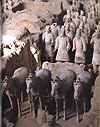Questions on the Reading
|
Week 3
|
|
 |
|
|
|
| Questions on the Reading for week 3 |
| Tuesday: |
Sources of Chinese Tradition, pp. 206-212, 235-263,
268-310. |
| |
|
| Thursday: |
Sources of Chinese Tradition pp. 325-352, 367-374.
*"An Early Poem of Mystical Excursion," "Seduction Song of One
of the Perfected," "The Method for Collecting and Swallowing
the Yin Flowers ." |
|
|
Introduction to "The Early Empire: Institutions and
Historiography of the Qin and Han Dynasties."
The foundation of a unified empire by the First Exalted Emperor
of the Qin dynasty (Qin Shihuangdi, r. 221-210) was a monumental
event. The emperor acquired unprecedented control over human and
material resources which he mobilized to realize his grand vision
of empire. He built roads and walls, standardized weights and measures
and the writing system, replaced the feudal aristocracies with a
non-hereditary bureaucratic system, instituted an elaborate code
of law, erected stone stelae on mountains across the empire to proclaim
his virtue, and constructed a colossal tomb complex for himself,
protected by the famous terracotta armies.
This vision of empire also inspired new views of the past, of government,
and of the cosmos. The emperors of the Qin (221-207 BCE) and Han
(202 BCE-220 CE) dynasties personified the empire and represented
mankind in its relationship to the cosmos. They therefore attempted
to maintain strict control over all representations of empire and
cosmos in ritual, in monuments, and in writing. The selections in
chapters seven through twelve of the Sources of Chinese Tradition
combine excerpts from histories (Shiji, Hanshu) and from collections
of philosophical essays (a.o., Lüshi chunqiu, Huainanzi, Chunqiu
fanlu) to reflect on the institutions, cosmology, economy, and historiography
of the Qin, Han, and Xin (9-23 CE) empires.
|
| |
 |
Han Cosmic Mirror. The mirror is believed to represent
a square earth and round heaven. |
|
| |
|
| |
The Terra-Cotta Army Near the First Emperor's Mausoleum,
Lintong, Shaanxi Province.
The terra-cotta army of the first Chinese emperor, Shihuangdi
(r. 246-210 BCE), while undeniably a dramatic find, constitutes
but one element of an enormous and complex necropolis, the
construction of which reportedly began with the emperor's
accession to the throne. Its massive scale sets it apart from
other burials, but the Lintong necropolis nonetheless represents
a continuation of more than five centuries of Qin funerary
structures and beliefs, and its design integrated elements
of non-Qin funerary structures.
At the center of the necropolis, enclosed within two sets
of walls lies an as-yet unexcavated underground tomb chamber,
marked by an enormous tumulus. According to a famous passage
in Sima Qian's (c. 145 - 86 BCE) Shi ji (Records of the historian)
the tomb chamber was built as a microcosm of the universe,
with waterways made of mercury and depictions of celestial
constellations and terrestrial topography. Excavated components
of the Lintong necropolis, however, indicate that the microcosm
extended beyond the tomb itself. Nearly one hundred pits,
containing hundreds of horse skeletons and kneeling terra-cotta
figures of grooms, were discovered to the east of the compound's
outer wall; inscriptions identify these pits as "imperial
stables." Nineteen tombs located near the tumulus have
yielded human remains, possibly those of officials and retainers
to accompany the emperor in death. Two half-size models of
chariots, each pulled by a team of four horses and manned
by a driver -all carefully rendered in bronze - were buried
to the west of the tumulus within the inner wall of the necropolis;
they were probably intended as transport for the emperor in
the afterlife. (See detail image at right.) In the same pit,
large quantities of the organic remains of hay were found,
suggesting that these structures represented depots. Between
the inner and the outer wall on the west side of the tumulus,
a cluster of small pits contained clay models and the remains
of various birds and animals; the pits may have been intended
to represent the emperor's parks and forests.
The terra-cotta army was found in three pits - underground
wooden structures - located about 1.25 kilometers east of
the tumulus. Pit 1 contained approximately six thousand warriors
and horses, as well as several chariots, in battle array in
eleven parallel trenches. Pit 2 contained some fourteen hundred
figures - cavalrymen, infantry, and horses - as well as ninety
wooden chariots. Pit 3 contained sixty-eight soldiers, one
chariot, and four horses. A fourth pit, much shallower than
the other structures, was empty. The contents of the first
three pits were looted and the structures burned, apparently
by the army of Xiang Yu, soon after their completion.
|


|
|
| |
| Questions |
|
- Han philosophy is often called a "synthesis." What does that
mean? How does Han philosophy relate to Warring States philosophy?
Which issues do Han philosophers inherit, and which issues do
you perceive as new?
- How did the dynastic houses use historiography to legitimize
their power? Do you feel that this affects the reliability of
the histories compiled in this period? How did the historians
view their own work?
- If histories and philosophical essays speak to the same issues,
is it still valid to distinguish between politics, history, economy,
and morality? How do these pursuits relate to each other, and
how would you distinguish between them?
|
|